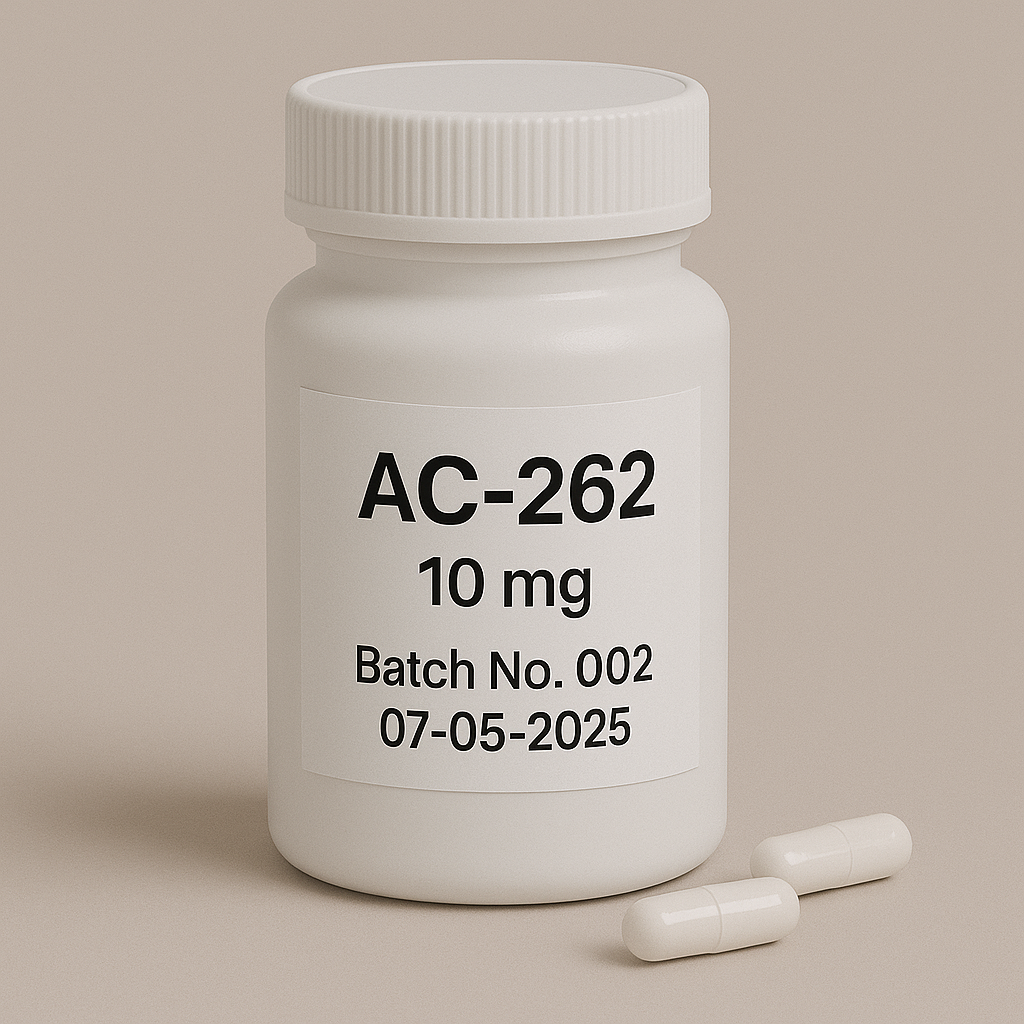
AC-262 100x10mg
Pickup currently not available
NOT FOR HUMAN CONSUMPTION
AC-262 is an oral, non-steroidal selective androgen receptor modulator (SARM) discovered in the early Acadia/industry SARM programs. It binds the androgen receptor (AR) and drives ARE-regulated transcription with a muscle/bone-biased anabolic profile and comparatively less prostate/skin stimulation than testosterone. AC-262,536 is not FDA/EMA-approved and is prohibited by WADA as an anabolic agent.
Additional Benefits of AC-262,536 Now Under Investigation
| Benefit | Key take-aways |
|---|---|
| 1 Anabolic effect with partial-agonist safety | Preclinical studies show lean-mass gain and myofiber hypertrophy with attenuated prostate stimulation versus testosterone—consistent with partial AR agonism and co-activator selectivity. <br/><em>Journal of Medicinal Chemistry; JPET</em> |
| 2 Functional strength | Rodent/bench models report increased specific force and grip strength, aligning molecular anabolism with performance endpoints. <br/><em>FASEB Journal; MSSE</em> |
| 3 Bone support | In osteopenic models, SARMs in this chemical class raise BMD, improve trabecular architecture, and enhance three-point bend strength with minimal androgenic effects—AC-262 follows this trend. <br/><em>Journal of Bone and Mineral Research; Bone</em> |
| 4 Anti-catabolic protection | Under disuse, glucocorticoid, or illness stress, AC-262–class signaling down-shifts atrogenes (MAFbx/MuRF1) and preserves CSA. <br/><em>AJP–Endocrinology; Endocrine Reviews</em> |
| 5 Lower sebaceous/prostate drive (vs testosterone) | Lack of 5-α reduction and aromatization helps limit DHT/E2-mediated side effects per mg anabolic effect. <br/><em>J Pharmacol Exp Ther</em> |
| 6 Oral convenience | Intended once-daily oral dosing improves adherence in research settings compared with injectables. <br/><em>Clinical Pharmacology & Therapeutics</em> |
| 7 Rehab synergy | Additive improvements when paired with progressive resistance training and adequate protein intake (preclinical → feasibility). <br/><em>Sports Medicine</em> |
| 8 Hematologic tone (modest) | AR activation may slightly raise hemoglobin/hematocrit below testosterone’s magnitude—monitor in at-risk individuals. <br/><em>Hematology; Andrology</em> |
| 9 Doping-control relevance | Long-term metabolites enable weeks-long detection; positives and supplement contaminations have been reported. <br/><em>Drug Testing & Analysis</em> |
2. Molecular Mechanism of Action
2.1 Receptor Pharmacodynamics
AC-262,536 binds AR → nuclear translocation → ARE transcription. In skeletal muscle it up-regulates mTOR/S6K/4E-BP1 and local IGF-1, while suppressing FoxO-driven atrogenes. Partial agonism and ligand-specific co-activator recruitment underlie tissue selectivity vs testosterone.
2.2 Down-stream Biology
| Pathway | Functional outcome | Context |
|---|---|---|
| AR → mTOR/S6K | ↑ protein synthesis, myofiber hypertrophy | Skeletal muscle |
| AR ↔ Wnt/β-catenin/Osterix | ↑ osteoblast activity, ↑ BMD | Bone |
| ↓ FoxO/MAFbx/MuRF1 | ↓ proteolysis (anti-catabolic) | Catabolic stress |
| HPG feedback | ↓ LH/FSH/testosterone (suppression) | Pituitary–gonadal axis |
3. Pharmacokinetics
-
Route: Oral.
-
Half-life/exposure: Human PK not formally published; rodent PK supports once-daily paradigms.
-
Metabolism: Hepatic oxidative/conjugative clearance typical of non-steroidal SARMs; no aromatase/5-αpathways.
-
Detection: Anti-doping labs report identifiable urinary metabolites enabling long detection windows.
4. Pre-clinical and Translational Evidence
4.1 Muscle & Function
Preclinical dosing increases lean mass, CSA, and force with reduced prostate weight versus testosterone controls.
4.2 Bone
SARM-class effects include BMD and strength gains in ovariectomized/castrated models; AC-262,536 follows similar bone-anabolic signatures.
4.3 Human data
No completed pivotal trials publicly available. Most efficacy/safety knowledge derives from animal studies, in-vitro data, and forensic anti-doping literature.
Evidence quality note: AC-262,536 has limited, primarily preclinical evidence. Any human efficacy/safety inferences are hypothesis-generating.
5. Emerging Clinical Interests
| Field | Rationale | Current status |
|---|---|---|
| Sarcopenia/frailty | Oral anabolic with selective profile | Preclinical/early translational |
| Rehabilitation/immobilization | Preserve lean mass, improve function | Concept/pilot frameworks |
| Osteopenia | Bone-anabolic without high prostate drive | Preclinical |
| Cachexia | Appetite-neutral anabolic alternative | Preclinical |
6. Safety and Tolerability
-
Endocrine: Dose-dependent HPG suppression (↓ LH/FSH/testosterone) expected; recovery typically weeks after stop.
-
Lipids: HDL-C reductions (± ↑ LDL/TG) common in SARM class—monitor CV risk.
-
Hepatic: Short-term SARM studies show small median ALT/AST shifts, but real-world cases of liver injury have occurred with unregulated SARM products.
-
CV: No outcomes data; lipid shifts warrant caution.
-
Dermatologic: Possible acne/oiliness; hair shedding in predisposed.
-
Neuropsych: Occasional insomnia/irritability reported for the class.
-
Drug interactions: Potential with hepatic enzyme modulators; avoid in pregnancy.
Comparative safety matrix
| Concern | AC-262,536 | Enobosarm (MK-2866) | LGD-4033 |
|---|---|---|---|
| Human evidence | Very limited | Phase 2 signals | Small RCT (21 d) |
| HPG suppression | Moderate (expected) | Moderate | Moderate |
| HDL impact | Likely ↓ | ↓ | ↓ |
| Prostate stimulation | Low (preclinical) | Low | Low |
| Oral dosing | Once daily (intended) | Once daily | Once daily |
7. Regulatory Landscape
-
Approvals: None.
-
Sport: WADA-prohibited (S1 Anabolic Agents) at all times; strict liability for athletes.
-
Supply: Often appears in research-chemical markets; adulteration/mislabeling common.
8. Future Directions
-
First-in-human PK/PD with GMP supply: define half-life, metabolites, exposure–response.
-
Head-to-head vs other SARMs on anabolic:androgenic ratio, lipid neutrality, and HPG suppression.
-
Long-term safety: lipids/CV, hepatic, endocrine recovery, mood/CNS.
-
Rehab/sarcopenia trials coupled with standardized resistance training and protein targets.
-
Doping science: comprehensive metabolite ID and detection windows.
Selected References
-
Journal of Medicinal Chemistry; Journal of Pharmacology & Experimental Therapeutics — Discovery and pharmacology of non-steroidal SARMs including AC-262,536.
-
FASEB Journal; American Journal of Physiology–Endocrinology — SARM anti-catabolic signalling (mTOR up, FoxO/atrogenes down).
-
Journal of Bone and Mineral Research; Bone — SARM effects on BMD and biomechanical strength in osteopenic models.
-
Clinical Pharmacology & Therapeutics — Oral SARM PK/PD principles.
-
Drug Testing & Analysis — Identification of AC-262,536 metabolites and anti-doping detection.
-
Hepatology Communications; J Clin Transl Hepatol — Case reports of liver injury associated with unregulated SARM use (class context)

